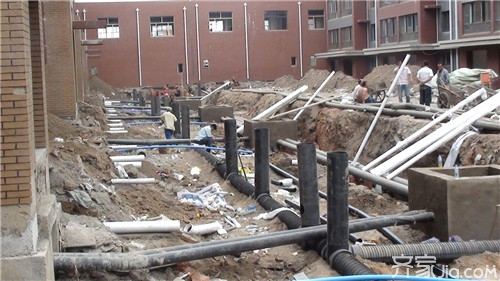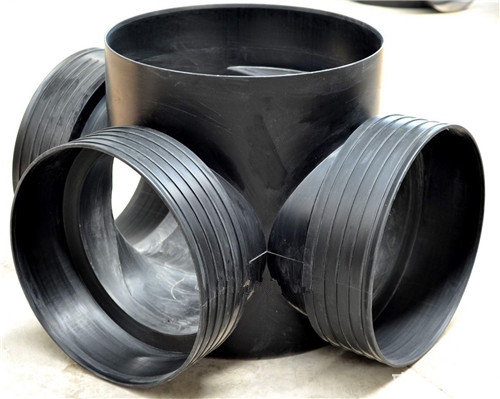Plastic drainage inspection wells are one type of inspection wells. Plastic drainage inspection wells is named "plastic inspection wells". Commonly known as "plastic wells." It is a kind of inspection well. Because of the use of polymer resin material injection molding, it is called the plastic drainage inspection well. The wellhead part of plastic inspection wells is mostly used for disposable injection molding. Connections such as reducers, angled joints, and rubber seals are used to change the pipe diameter and angle. The plastic inspection wells are matched with the well covers, well bores and related accessories. The road surface loads are applied around the inspection wells through the well cover and well block to avoid the destruction of the inspection wells caused by the pavement load. Xiao Bian collected relevant information. Let's take a look at what the plastic drainage inspection well is and what functional advantages it has. What is plastic drainage inspection well? Plastic inspection wells are used in construction areas (residential areas, public buildings, factories, etc.). The buried plastic drains have an outside diameter of no more than 800mm and a buried depth of no more than 6m. They are generally located at the intersection, turning, and pipe of the drainage pipelines. A well-like structure that is integrally injection-molded with a plastic for inspection that facilitates regular inspection, cleaning, and dredging or downhole operation, such as a change in the diameter or slope, and a drop point. The plastic inspection well means that the main well block that constitutes the inspection well is molded by using a polymer resin material at one time. According to different numbers and angles of take-up, there are starting wells, straight wells, 45-degree elbow wells, three-well wells, and four-well wells. In order to adapt to various drainage conditions, plastic inspection wells are also equipped with plastic integral injection molding accessories, such as adapters, manifolds, and well joints. To ensure the smoothness and tightness of the entire drainage system. Plastic inspection wells use macromolecule resin as raw material and adopt a combination structure, which is generally composed of inspection well wells, wellbore, and well covers, and is divided into sewage (waste) water inspection wells and rainwater inspection wells. Sewage wells are generally equipped with flow channels to facilitate the smooth discharge of dirt. Rain wells (generally equipped with silt chambers for sedimentation) are provided to facilitate later cleaning and maintenance. Selection of parts Connections between wells and buried pipelines should be made of flexible rubber seals to accommodate deformation of seats. Adhesives can only be applied to PVC-U material wells and bore diameters of 315 mm or less. . Plastic inspection well components selection: 1) An inspection well base with a gutter shall be used on the sewage pipeline; 2) Wells on rainwater pipelines should meet the following requirements: a. Road wells should use wells with muddy chambers; b. When an inspection well for a wellbore chamber well is to be installed on a rainwater pipeline, an inspection well with an outer diameter of the wellbore greater than or equal to 500mm shall be installed; c. Other well inspection wells can use flow wells; Functional advantage The functional advantages of plastic inspection wells are mainly five points: land saving, energy saving, water saving, material saving and environmental protection. (1), acid and alkali corrosion resistance, long service life. (2) Safety and environmental protection, sealed and leakproof. The material of the plastic inspection well is high-density polyethylene plastic non-toxic and odorless, and can be recycled after use; good sealing can prevent leakage and leakage of rainwater to prevent groundwater pollution. It belongs to chemical environmental protection building materials and conforms to the major policies of the national environmental protection. (3), uniform settlement and pressure resistance. The flexible connection between the pipeline and the well block, the joint movement of the pipeline and the clay in the well block, solves the problem of uneven settlement caused by the connection between the traditional inspection well and the plastic pipe, and effectively prevents the ground from collapsing. (4) Construction is quick and easy. With the separate assembly structure, the wellbore can be cut and adjusted on site to adapt to various installation depth requirements, effectively reducing costs, greatly improving the construction schedule, shortening the construction period by more than 10 to 20 times that of traditional inspection wells, and enabling all-weather construction and brickwork inspection Wells and other cement bricks cannot be compared with it. (5) Efficient drainage. The inner wall is smooth and smooth, with diversion grooves, dirt is not easy to retain, reduces the possibility of blockage, has excellent drainage performance, and the rate of rain and sewage discharge is 1-3 times that of conventional inspection wells. (6), light weight, easy to transport and install, reliable performance, strong bearing capacity; strong adaptability varieties, can adjust the height of the wellbore and punch holes in the cylinder, adjust the direction to meet all the needs of the project installation. (7) Low comprehensive construction cost, low maintenance cost, more advantages than traditional inspection wells, recycling and recycling, and huge social benefits. (8), good sealing performance, anti-leakage. Due to the flexible connection method, it is flexible and convenient to overcome the harsh construction environment of dust and dust. It can also overcome the difficulty of repeated insertion due to increased road surface. (9) Save materials. The plastic inspection well replaced the red brick cement with the polymer resin as the processing material, which saved the topsoil resources; the specifications used in the construction area were reduced, which greatly saved the space occupied by the inspection wells. Production Process 1. The plastic inspection wells produced by the injection molding process are molded once, with high production efficiency and good quality. The disadvantage is that the mold price is relatively high, and at the same time subject to raw material processing performance and power limitations of the injection molding machine, it is suitable for the production of plastic inspection wells with a diameter of 800 mm or less. 2. The advantage of the plastic inspection wells produced by the winding and overmolding process is to obtain materials locally, to be fast, and to produce inspection wells of different specifications. The disadvantages are slow speed, low efficiency, and the quality (especially the welding quality) is subject to fluctuations due to human factors. 3. The advantage of using the layered coating process to form a second-inspection well is that it can be quickly obtained from local sources and can produce plastic inspection wells of different specifications. The disadvantages are slow speed and difficulty in mass production. With pure manual production, the product size and performance are difficult to guarantee. Environmental pollution and raw materials in production cannot be recycled, limiting its production and use. 4. The hardness of plastic inspection wells produced by rotomolding process is high. Summary: The relevant information on what plastic drainage wells are and what are their functional advantages is introduced here. I hope this article will be helpful to everyone. If you still have something you don't understand, you can leave a message to Xiaobian at the bottom. We will answer your questions as soon as possible. Plastic shower room plastic carpet plastic drawer storage cabinet plastic curtains plastic waterproof board
A Tape Measure or Measuring Tape is a flexible Ruler and used to measure distance.
It consists of a ribbon of cloth, plastic, fibre glass, or metal strip with linear-measurement markings. It is a common measuring tool. Its design allows for a measure of great length to be easily carried in pocket or toolkit and permits one to measure around curves or corners. Today it is ubiquitous, even appearing in miniature form as a novelty item sb use tape measures in lengths of over100m.
There are two basic types of tape measures with cases, spring return pocket tape measures and long tape measures. Spring return pocket tape measures will generally fit in a pocket. They are small, the case is up to about three inches across. The tape is returned to the case by a spring mechanism. Pocket tape measures have a tape one foot to fifteen feet in length and ¼ to ¾ inches across. When most people think of a tape measure, they are thinking of the pocket tape measure.A second tape measure design is what is called the long tape. These are cased tape measures with tapes of 25, 50, 75, 100, 200, 300, and even 500 feet in length, designed for engineers and builders. Because surveying was usually done in rods, surveyors use long tapes of 33 feet (2 rods), and 66 feet (4 rods). Surveyors also used 49½ feet of a 50-foot tape for 3 rods and 99 feet of a 100-foot tape measure for 6 rods. Long tapes instead of being returned by a spring, were usually returned by hand crank.
Mm Tape Measure,Tape Measure For Dummies,Rolling Tape Measure,Three Stop Measuring Tape Oukelong Tools Co.,Ltd , https://www.oukelongtape.com

